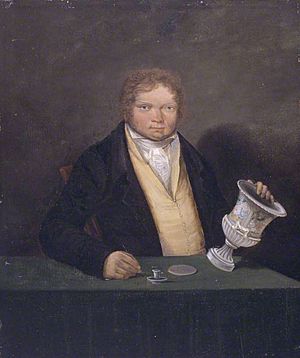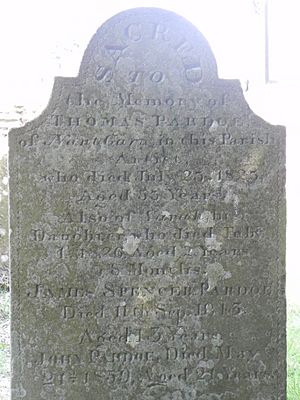Thomas Pardoe facts for kids
Thomas Pardoe (born July 3, 1770 – died 1823) was a British artist famous for painting flowers on enamel. Enamel is a smooth, glassy coating that is melted onto metal or pottery.
Contents
Who Was Thomas Pardoe?
Thomas Pardoe was a skilled artist who lived a long time ago. He was known for his beautiful paintings of flowers, especially on special materials like enamel and pottery. His work is still admired today.
Early Life and Training
Thomas Pardoe was born in a town called Derby in England. When he was a teenager in the 1780s, he started learning his craft. He became an apprentice at a porcelain factory in Derby. Being an apprentice meant he worked and learned from experienced artists. Later, he moved to another city called Worcester.
A Master of Enamel Painting
Pardoe became very good at painting on pottery and glass. He was known as an "enameler" and a "gilder." A gilder is someone who adds gold decoration to objects.
Working in Swansea and Bristol
Between 1795 and 1809, Thomas Pardoe worked in Swansea, a town in Wales. There, he painted on a type of pottery called "creamware." He was influenced by a potter and plant expert named Lewis Weston Dillwyn. Pardoe also worked with another artist, William Weston Young.
After Swansea, Pardoe moved to Bristol. He worked independently there, meaning he had his own business. He would decorate china and pottery that was supplied to him plain, often from factories like Coalport.
His Unique Style
Thomas Pardoe was special because he often signed his work. Pieces he decorated in Bristol are sometimes signed "Pardoe Bristol." This helps us know which pieces he personally painted. He was especially famous for his detailed paintings of plants and flowers, known as "botanical scenes." He also painted on glass, not just pottery.
Later Years and Legacy
In 1821, Thomas Pardoe went to Nantgarw in Wales, invited by his friend William Weston Young. He passed away in 1823 and was buried in a churchyard in Eglwysilan, South Wales. Today, some of his original drawings and sketches can be found in the famous V&A Museum in London.
His Son's Business: Nantgarw Pottery
Thomas Pardoe's son, William Henry Pardoe, continued the family's connection to pottery. In 1833, he took over the Nantgarw Pottery.
Making Pipes and Pottery
William Henry Pardoe started making different kinds of pottery. He made strong "stoneware" bottles and brown "earthenware" known as Rockingham pottery. He also became well-known for making clay tobacco pipes. Many of these pipes were sent to Ireland.
The family business kept going for many years, passed down through generations. At its busiest, the factory made about 10,000 clay pipes every week! However, the business closed in 1920. This was because cigarettes became popular, and people stopped using clay pipes as much.



